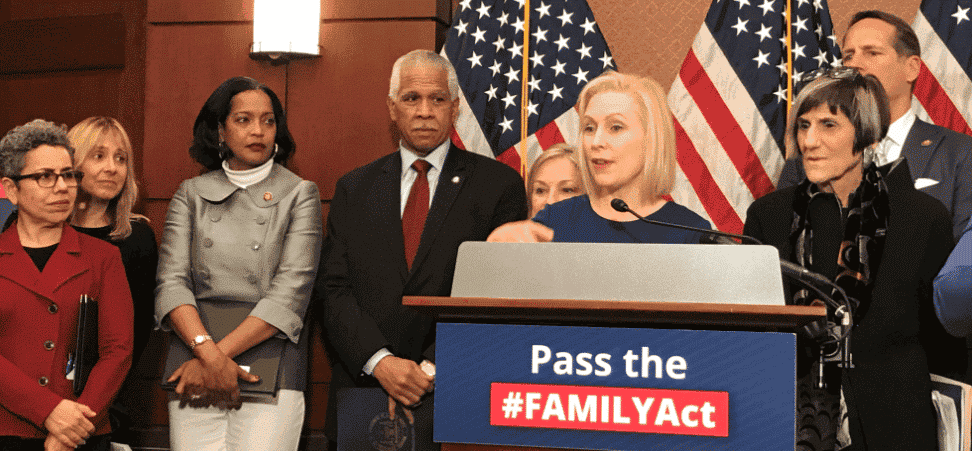What is the FAMILY Act?

We all want healthy children, time with our family, strong communities, and a thriving economy. That’s why Senator Kirsten Gillibrand (D-NY) and Rep. Rosa DeLaura (D-CT) have introduced The Family And Medical Insurance Leave Act (FAMILY). It provides up to 12 weeks of paid leave each year to qualifying workers for the birth or adoption of a new child, and for self-care or the care of a seriously ill family member. Workers would be eligible to collect benefits equal to 66 percent of their typical monthly wages, with a capped monthly maximum amount.
Why Do We Need the FAMILY Act?
Currently only 17 percent of U.S. private sector workers have access to paid family leave through their employers – and less than 40 percent have personal medical leave through an employer-provided temporary disability program. That means millions of workers who develop serious health conditions, have seriously ill family members or welcome a new child are forced to choose between what is best for them and their families and the income they need to cover basic expenses.

The workforce has changed. According to the Department of Labor Women’s Bureau, 62% of women with children under the age of 3 are in the paid workforce. More men need and want to participate in caregiving. All workers need dedicated time to fulfill both their responsibilities at work and at home, no matter who they love or where or how they do their job.
The U.S. is the only industrialized nation without some form of maternity leave. Three-quarters of OECD countries also guarantee paid leave to the father or co-parent. Many wealthy nations have additional mechanisms to ensure workers receive paid time to care for their own illnesses or to care for family members.
Doesn’t the FMLA Provide This Benefit?
The Family Medical Leave Act of 1993 has provided job-protected, family and medical leave more than 200 million times. But the leave is unpaid. And it doesn’t cover workers in firms with fewer than 50 employees – leaving out 40 percent of the workforce.
A 2012 DOL survey showed millions of eligible workers each year forego treatment or go back to work too soon, mainly because they cannot afford unpaid time. Nearly a quarter of pregnant workers reported going back within two weeks of giving birth.
How Will the FAMILY Act Work?
The FAMILY Act calls for the establishment of an Office of Paid Family and Medical Leave to collect contributions and administer benefits.
Employers and employees will contribute 0.2% of wages (2 cents for every $10 earned) to a central fund, which will be housed within the Social Security Administration.
The FAMILY Act guarantees eligible applicants a family and medical leave insurance payment beginning the first month of eligibility and ending the 365th day in the year. For a full-time employee, this amounts to 12 weeks of coverage per year to be used at one time or intermittently.
Eligible employees must have earned wages from an employer during the 12 months prior to filing for benefits.
What We Know About Paid Family and Medical Leave Programs
These programs have led to a number of positive outcomes, including higher rates of involvement by men and women returning to the workforce in greater numbers and with higher wages. A definitive body of evidence shows the majority of employers in CA and in NJ said paid leave has resulted in “positive effects” or “no noticeable effect.”
Paid leave can lead to shorter hospital stays, improved health outcomes, decreased costs.
It reduces infant mortality and produces better long-term health outcomes, especially for children with chronic health conditions.
Paid family and medical leave promotes the wellbeing and Independence of seniors.
Replacement income provided by the FAMILY Act goes right back into the local economy, boosting businesses, as workers make purchases to cover the basic needs.
Our Nation is Ready for Paid Family and Medical Leave
There is a successful track record for the implementation of paid leave programs. Since the 1940s, five states have provided temporary disability insurance through a social insurance fund. Four of those states — CA, NJ, RI and NY– expanded the funds to include paid family leave. The District of Columbia, Washington, Massachusetts, Connecticut and Oregon have also passed laws and are currently setting up systems.
A Washington Post poll found that more than four-fifths of voters – including 94 percent of Democrats, 80 percent of Independents and 65 percent of Republicans – agree that workplace rules to ensure paid time off to care for family members “is good for our nation.”
Our network has joined with other organizations to form the Paid Leave For All Campaign. Together we are working with legislative champions to update the FAMILY Act to reflect lessons learned in the states, including adding progressive wage replacement so the lowest-paid workers receive up to 90 percent of their pay, providing job protection and anti-retaliation protection for all leave-takers, and using an inclusive definition of family.